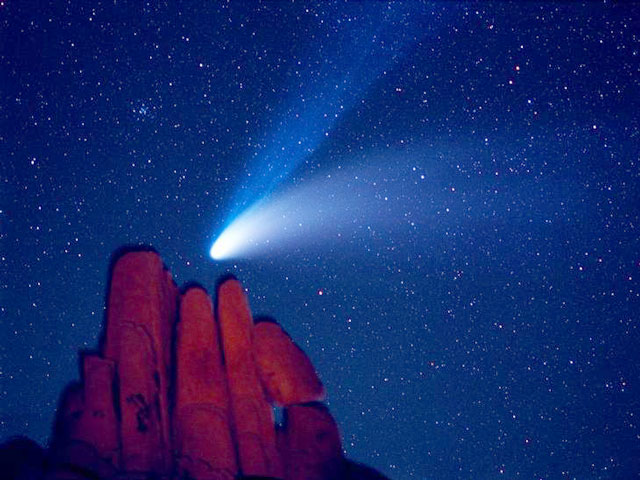 |
Астронет: Астрономическая картинка дня Комета Хейла-Боппа над Индейской пещерой http://www.variable-stars.ru/db/msg/1197706/eng |
Credit & Copyright: Wally Pacholka (Astropics)
Wally Pacholka
Explanation:
Comet Hale-Bopp, the
Great Comet of 1997, was quite a sight.
No comets of comparable brightness have graced the skies of
Earth since then.
During this next month, however,
even besides the fleeting
Comet Bradfield,
two
comets have a slight chance of rivaling
Hale-Bopp
and a good chance of putting on a
memorable sky show.
Unfortunatetly, most of the show will be confined to
sky gazers in Earth's
southern hemisphere.
Both comets are already
visible to the unaided eye from there.
The first,
Comet C/2002 T7 (LINEAR), should be at its best
before dawn during the first weeks of May from the south.
The second,
Comet C/2001 Q4 (NEAT),
should be visible in early May from all over the Earth.
Both comets appear to be
approaching the inner Solar System for the first time and so it is very
hard to predict how bright each will become.
In the
above photograph
taken 1997 April 6, Comet Hale-Bopp was imaged from the
Indian Cove Campground in the
Joshua Tree National Forest in
California,
USA.
A flashlight was used to momentarily illuminate foreground
rocks during this six minute exposure.
Authors & editors:
Robert Nemiroff
(MTU) &
Jerry Bonnell
(USRA)
NASA Web Site Statements, Warnings,
and Disclaimers
NASA Official: Jay Norris.
Specific
rights apply.
A service of:
LHEA at
NASA /
GSFC
& Michigan Tech. U.
